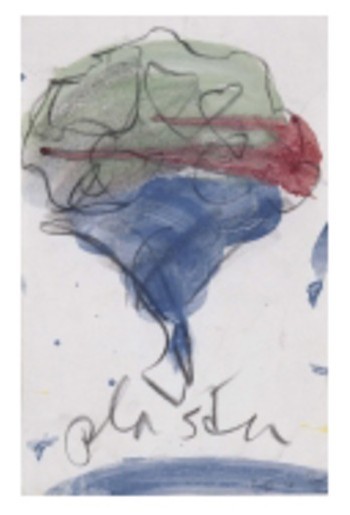Claes Oldenburg
02 Oct 2012 - 13 Jan 2015

Claes Oldenburg
Notebook Page: Study for a Sculpture in the Form of a Bouquet, 1961-1962
Kupferstichkabinett, Staatliche Museen zu Berlin
© Claes Oldenburg / Photo: Staatliche Museen zu Berlin, Jörg P. Anders
Notebook Page: Study for a Sculpture in the Form of a Bouquet, 1961-1962
Kupferstichkabinett, Staatliche Museen zu Berlin
© Claes Oldenburg / Photo: Staatliche Museen zu Berlin, Jörg P. Anders
CLAES OLDENBURG
Works on Paper
2 October 2012 - 13 January 2013
This exhibition combines drawings and lithographs which Claes Oldenburg made in the 1960s. Born in Stockholm in 1929, the American Pop artist increasingly turned to the world of consumer culture for inspiration in the early 1960s. This is reflected in his drawings on The Street (1960) and The Store (1961-1963). Oldenburg distilled his impressions of the streets of Manhattan in these two environments that he temporarily installed at various places in New York. He did this by creating shop situations from simulated consumer products (The Store), or attempting to replicate urban life in gallery rooms (The Street).
While his sketches, mostly rendered in small notebooks, provide an insight into the genesis of the two walk-in environments, the twelve lithographs from Notes (1968) aim, as Oldenburg puts it, to give permanent form to 'the words and images scribbled down on random pieces of paper over the course of the day'. In their execution, the 'printed' drawings bear reference to the earlier sheets, but also incorporate additional visual elements. The quality of the lithographs is evident in the reproduction of materials integrated by Oldenburg, such as lined writing paper and sticky tape.
The works on paper are an impressive demonstration of the importance of the quick sketching out of ideas in Oldenburg's plastic thinking and also reflect the underlying artistic strategy behind his work. These drawings and prints complement his work as a sculptor and can be viewed as a creative step in the process behind individual sculptures or installations.
The playfully vivid, even expressive character of Oldenburg's drawings is utterly unique within Pop Art. At the same time, Oldenburg breaks down aesthetic boundaries by isolating what are, in effect, trivial objects. The monumentalizing of such things as an ice-cream cone or the outline of Mickey Mouse to the point that they become absurd makes us question the objects' significance.
Works on Paper
2 October 2012 - 13 January 2013
This exhibition combines drawings and lithographs which Claes Oldenburg made in the 1960s. Born in Stockholm in 1929, the American Pop artist increasingly turned to the world of consumer culture for inspiration in the early 1960s. This is reflected in his drawings on The Street (1960) and The Store (1961-1963). Oldenburg distilled his impressions of the streets of Manhattan in these two environments that he temporarily installed at various places in New York. He did this by creating shop situations from simulated consumer products (The Store), or attempting to replicate urban life in gallery rooms (The Street).
While his sketches, mostly rendered in small notebooks, provide an insight into the genesis of the two walk-in environments, the twelve lithographs from Notes (1968) aim, as Oldenburg puts it, to give permanent form to 'the words and images scribbled down on random pieces of paper over the course of the day'. In their execution, the 'printed' drawings bear reference to the earlier sheets, but also incorporate additional visual elements. The quality of the lithographs is evident in the reproduction of materials integrated by Oldenburg, such as lined writing paper and sticky tape.
The works on paper are an impressive demonstration of the importance of the quick sketching out of ideas in Oldenburg's plastic thinking and also reflect the underlying artistic strategy behind his work. These drawings and prints complement his work as a sculptor and can be viewed as a creative step in the process behind individual sculptures or installations.
The playfully vivid, even expressive character of Oldenburg's drawings is utterly unique within Pop Art. At the same time, Oldenburg breaks down aesthetic boundaries by isolating what are, in effect, trivial objects. The monumentalizing of such things as an ice-cream cone or the outline of Mickey Mouse to the point that they become absurd makes us question the objects' significance.
